By Tom in Oregon
Durning the FNS-40 contest I decided to rummage through the safe for an FN-related object. I found what I was looking for and since I knew where its brother was, I called my buddy and got his for a photo session. A few months back, my friend and I were negotiating a deal with a gentleman for a shop full of reloading equipment, components and whatever else the gent was looking to sell. He had several guns set to go on the auction block, too. As my friend had already bought three from him at very reasonable prices, I knew I was in, too . . .
After inspecting all of the Dillon equipment he had, a price was settled upon. We loaded everything up and were walking out the door when the gent said, “reach into one of those boxes.” I did and pulled out a shotgun that looked very familiar, but in 35 years of gun shows and collecting, I had never seen one before.
It was a Browning A5 with a mag extension. The gent then had me pull another from another box. He then proceeded to give them to us. In our circle, a shiny object (or blued in this case) given, gets a shiny object in return. We each handed him our EDC pocket knives in return. Mine was a favorite Al Mar Mini SERE. I don’t remember what knife my friend handed him.
The gent got a tear in his eye and remarked that this was better than money. We parted, happy in new-found friends.
After getting home, I started using my best Google-fu to find the story behind these cool looking pieces. Seems back in the late 60’s and early 70’s, FNH made these smoothbores for the South African police. Somewhere along the line, they ended up in service during the Rhodesian Bush War. After that, Century Arms imported somewhere between 250 and 500 of them. This was back in the early 1990‘s.
As you can see from the photos along with FNH’s serial number and other markings, the three letters POL are below. This appears to verify the police issue. Also on the receiver, bolt and barrel, they are stamped and engraved RA-XXX, (with the x’s actually being 3 numbers). This also seems to verify the use by the Rhodesian Army.
Here is a picture I found regarding the Rhodesian Bush War. Notice the black fellow in the center of the picture. There is another one on the right.
The shotguns were coated with a heavy grease/cosmoline when we got them. Not being up on the inner workings of an A5 shotgun, a competent gunsmith was enlisted to take them apart, give them a thorough cleaning and test them for safety.
Their condition after return was terrific. As old as they are, they function very well, even with low brass #8. No hiccups so far.
Sights are a simple bead front sight, with a flat, grooved receiver.
Safety is a common cross bolt, set behind the trigger. Bolt release if it is locked back is a familiar button on the right side of the receiver just below the charging handle.
A unique feature is the magazine tube lockout lever. If you load the tube with 7 rounds and flick the lever rearward, you can then load one round at a time in the ejection port and fire. Flick the lever forward and it releases the tube magazine to freely auto load the rounds.
It is a heavy beast, coming in at 8-1/2 pounds empty. Depending on what you load, add 8 rounds of 2-3/4″ 12 gauge ammo and it’s just under 10 pounds.
I think one full oak tree was cut down to make each shotgun. As you can see in the photos, that is a large piece of oak fore-end.
In reading past articles on these, I found that they were frequently issued to the point man in a unit. I can’t imagine lugging this beast through the jungle, but what a formidable weapon it is. It now makes a fine home defense weapon, and it matches the furniture to boot! Honey Oak.
I hope you enjoyed this brief bit of info and pictures on a couple of pieces of fine FN history. And no, they aren’t for sale. But if you find yourself up in my neck of the woods, I’ll gladly let you shoot it.

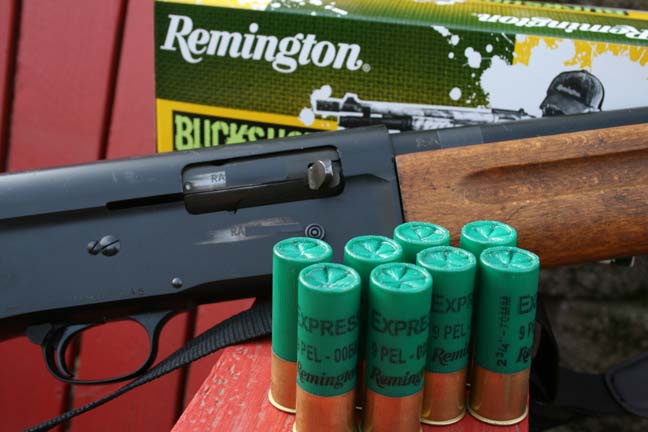
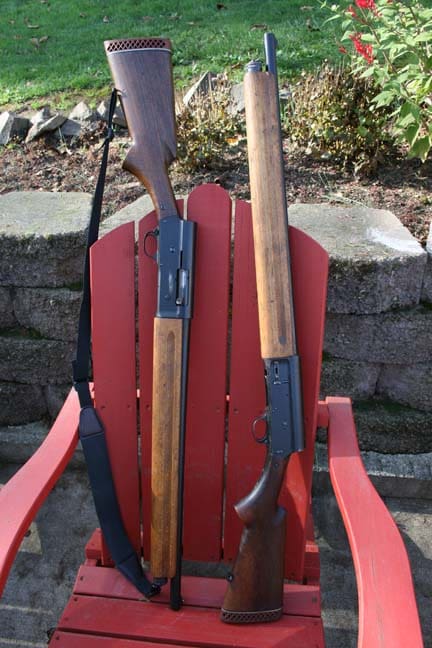

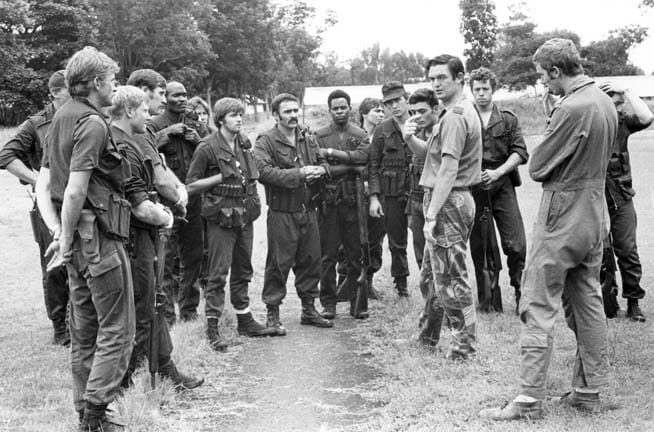

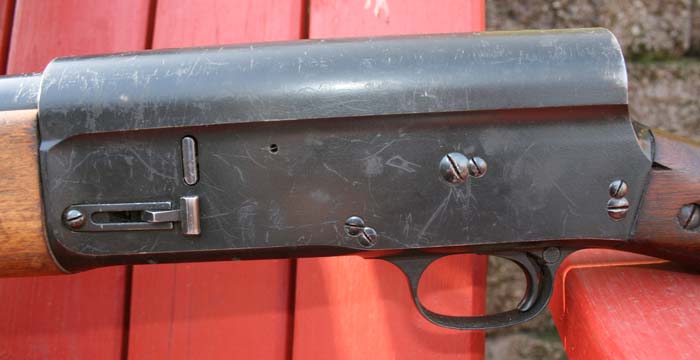


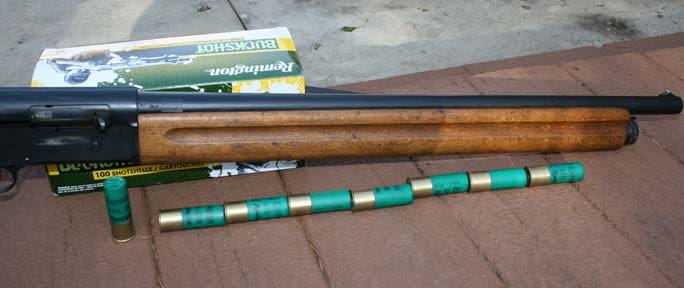
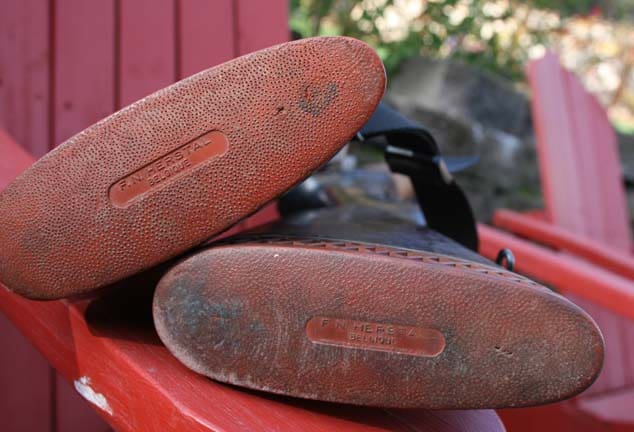



Want.
What a fine weapon. There is just something about a bit of history that imparts life into these old guns. Great piece, thank you!
Yes, I enjoyed it. The first gun I ever owned, at 16, was a standard Belgian A5 12 gauge. Nothing but ducks. A gun specially adapted to its immediate intended environment of use brings the reality of that environment alive. Thanks. I see a kinship between this A5 and my Benelli M4 7+1+1. A good defensive concept endures. Heavy is good when cranking out buckshot in a hurry without a muzzle break.
So is there something special about this I should know of, that a Mossberg or a Remington don’t do?
The post isn’t highlighting what can be done today, but what was actually done in a particular time and place many years ago.
History, son. History. The first successful semi-auto shotgun design (that John Browning reportedly considered his best design) is certainly worth a few words of discussion. It’s a cool gun, do we need any more reason than that?
Other than the fact the A-5 was a truly innovative design, many features of which went on to appear in many other guns?
No, I guess not.
Mossberg and Remington are least-cost emulators, not innovators. So if rock-bottom price is your metric of “good” in a gun, they’re your choice.
Don’t forget the crazy long production run. Nothing else comes close (Not counting the Colt 1911, everyone makes those, I’m talking about continuous production by FN and later in Japan).
I want to shoot it! And I’m in your neck of the woods!
Ask Dan Z or Matt in FL for my email addy.
The Auto-5 is still by far the greatest shotgun ever invented. And 2nd place isn’t even close. The Sweet 16 is my favorite upland gun and the mag 12 will take everything else that flies. I know folks bow at the alter of the 1911 design, but the a-5 and superposed were JMBs best work IMHO.
What is the barrel length?
Right at 24 inches if I remember.
Wow, very cool article. Thanks for sharing.
You can not judge between then and now, other than technology. Those were, and still are, some serious firearms. (Friends are a currency never to be spent).
I’m an A5 fan, and this makes me tingly… Amazing pieces of history.
Love the A5. I’m always interested in their history, and don’t recall reading anything about these before. I’ll have to consult my copy of Shirley and Vanderlinden.
You need to take those to a 3 gun match!
Honestly even with the age they would probably do well, although that would be heavy to lug around. Imagine being the guy to show up with an A5, a m1 garland, and a 1911. That would make the mattch fun. Hey Nick if your listening imagine taking some old school equipment to a 3 gun, I’ve heard it’s been done before but it would make a great article/video…
Thats cool, Ive never seen an A5 used for combat (maybe the gangsters and G-men) between that and the FAL an ambush would have been the most horrid expression of lead and smoke I can imagine.
The A5 was used by the brits during the “Malaysian Emergency” of the 50’s. Their load was an all brass shell with a duplex load of buck and bird. In the tropical climate they were being used in it was felt that even a fairly minor birdshot wound would turn deadly without quality medical help.
In close, brushy or jungle type terrain having a point man equipped with a fast firing shotgun backed up by a patrol armed with light auto’s, stens, sterlings and brens was a great answer to sudden contact and ambush scenarios.
The brits in malaysia also found use for the m1 carbine.
“I can’t imagine lugging this beast through the jungle, ”
Good. Because there isn’t much of a jungle at all in Zimbabwe (nee Rhodesia). It’s mostly a veldt IIRC
Ah … History in the morning is almost better than coffee 🙂 Thank you for sharing your A-5’s … I have never heard of that variation … Guess it is true that one is never to old to learn something
All I can say is “awesome!”
Until the Remington 1100 surpassed it, the A-5 was the most-produced semi-auto shotgun in the civilian US arms market.
The A-5 was also the gun that severed the relationship between J.M. Browning and Winchester. Browning knew he had a winner on his hands and he wanted a percentage of the profits from the gun. Winchester’s management was used to paying Browning a flat fee for his designs. Winchester’s management was hopping mad at Browning’s suggestion of a royalty system, especially that this change in relationship was suggested by Browning with the A-5, which everyone could plainly see was going to be a home-run gun.
Winchester’s engineers went through all the trouble of drawing up the patent details and drawings and at the very end, after the patents had been applied for, the Browning/Winchester agreement of decades duration ceased. Winchester was left without a semi-auto shotgun. John Moses went over to Remington to offer up his shotgun design to them. Sadly, the president of Remington died of a heart attack as JMB was waiting to see him, and that was the end of that possible venture. How history might have been different…
JMB then went overseas to FN in Belgium, and this was the start of the long relationship that continues to this day of Browning designs being produced by an overseas arms company. Fortunately for us, FN still pays some attention to quality in guns, unlike US companies I could name (Freedom Group, cough, hack, wheeze).
The A-5 was produced by both FN and Remington (as the M-11), then Savage as the 720. FN produced A-5’s are metric in dimensions (NB this for replacement screws) and Remington M11’s are imperial sized threads/pins, as are the Savage 720’s. The finish on the FN A5’s is better, IMO.
While the A-5 seems heavy, it was meant as a duck gun to shoot heavy loads, and it was wickedly successful at this role – so much so that JMB was worried that the new conservation movement in the US would ban the A-5. This was the reason why JMB created the Superposed O/U shotgun – people were railing against the wicked effectiveness of the A-5 and its five-round mag capacity against ducks and geese. Eventually we ended up with the two-round mag plug requirement for waterfowling.
Winchester did eventually produce a recoil-operated semi-auto, known as the model 1911. We gunsmiths call it “The Widowmaker” and advise clients to not use the wretched thing and instead hang it on a wall. The reason being that you have to grab the barrel and cram it into the action to cock it; there is no bolt handle you can use to pull the bolt rearwards to cycle the action. Unless you’re a strong man with a wide arm span, you’ll probably not be able to pull this off (Winchester so helpfully provided a knurled section on the barrel to “assist” you in this matter), and many people put the gun butt-down on the ground and push the barrel downwards. Sometimes the gun would fire when people would let the barrel fly upwards, and if their head was in the line of fire… oh well.
Yep, lotta history in that A-5 shotgun.
I have a Remington Model 11 (virtually identical) that my dad bought the year I was born, (194X). Don’t forget to move the brass bushing when going from low brass to high brass shells. The manual for the gun is on line if you search. It will show you where the bushing goes for each.
Great article with interesting and slightly obscure subject.
I live for this kind of stuff; thanks for putting it up!
Simply amazing.
Articles like this are so good they must be fattening.
I’d love to have one of those. The history and novel appearance make these something of a want to own. I have a pair of short barreled (yes legal) Remington model 11 shotguns. These are Browning pattern guns made under license by Remington. I want an older A5 as well but they seem to have either dried up or become very expensive. I also had one in sweet 16 as a kid. got rid of it years ago for a 20 Winchester pump because of the lack of 16ga. ammo. Ah, the foolishness of youth….. Beautiful guns and a great article keep posting more of the same.
Have an issue of “EAGLE” Magazine, December 1981, where Leroy Thompson had an article about the “Malaya” Loads, those mixed shotshell loads with Buckshot and birdshot in the same shell. As a point of reference, ya’ll may be familiar with those sold by Firequest as “Rhodesian” loads (No affiliation to the company; merely an admirer of the historical context).
One of the interesting features of the A-5’s made since about the mid ’50’s is the speed load feature. With that you can take the gun with an open bolt, insert a shell into the mag, and have it loaded into the chamber. Because it uses a split, two piece lifter, It also removes the requirement to hold down the bolt release button to release the lifter to load the magazine. This significantly increases speed loading an empty gun on the clock. The necessary parts can also be fitted to the Remington Model 11. My Model 11 has the speed load, rifle sights, an extended mag and removable choke tubes. I have a lot of fun with it in club 3-gun matches. My antiques run and run, and I watch the newer stuff choke.
A few months back, my friend and https://banksnear-me.com/
I were negotiating a deal with a gentleman for a shop full of reloading equipment, components and whatever else the gent was looking to sell.
I am grateful that I was allowed to participate in your illustrious just fall forum. It is an amazing experience for me to be here with you, and I am always learning new things about the topics that are being discussed in this forum as a result of being here with you.
Comments are closed.